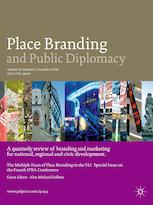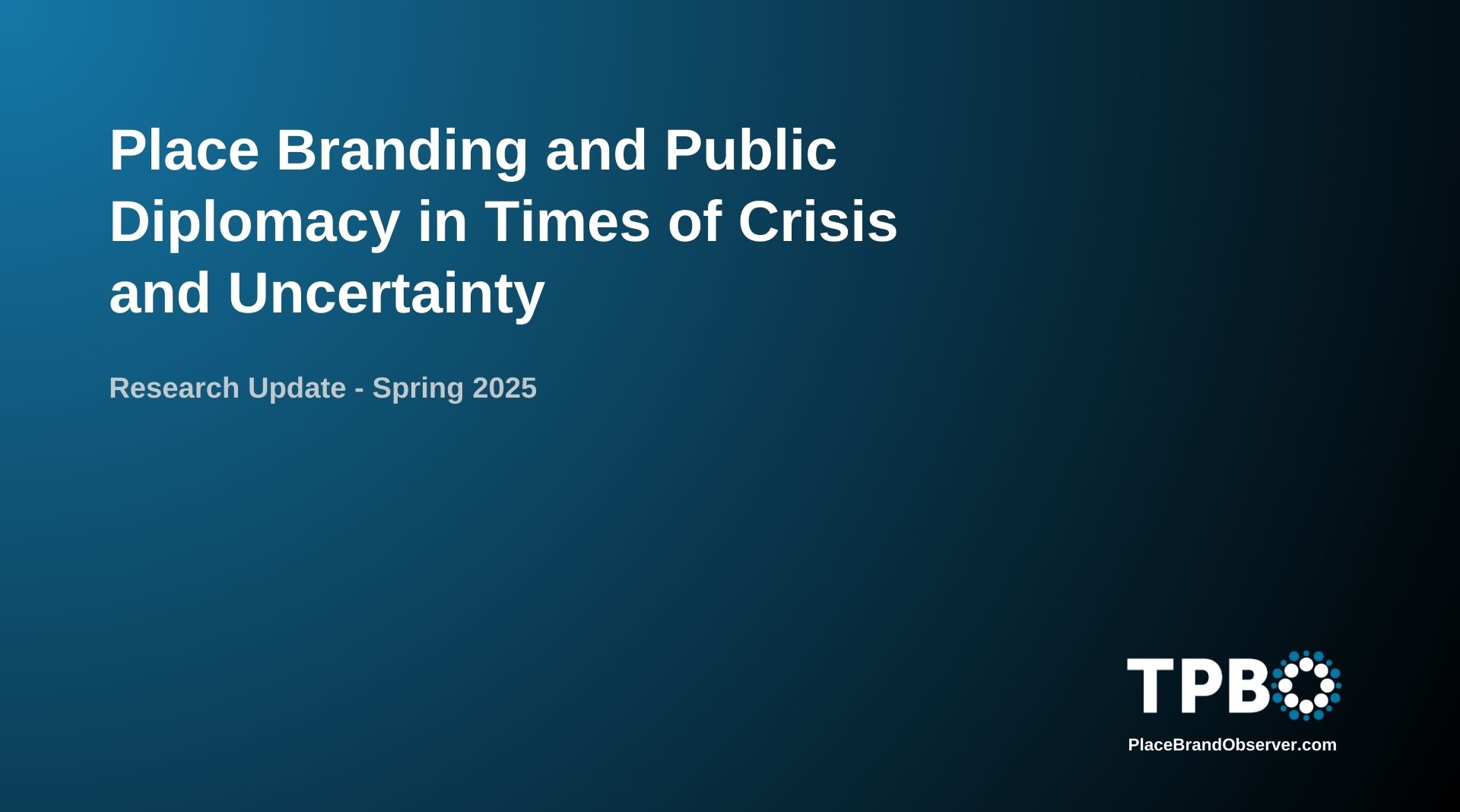In an era marked by climate change, social inequality, and economic uncertainty, place branding and public diplomacy have emerged as essential tools for cities, regions, and countries seeking to build resilience and strengthen their global presence. Beyond attracting investment, talent, and tourism, these strategies are increasingly used to foster social cohesion, promote sustainability, and respond to crisis.
The latest issue of the Journal of Place Branding and Public Diplomacy (Volume 21, Issue 1) brings together research presented at the seventh International Place Branding Association (IPBA) conference. Edited by the conference organizers, Cecilia Cassinger, Olga Rauhut Kompaniets, Lisa Källström & Ola Thufvesson.
Under the theme Place branding in times of crisis and uncertainty, the special issue explores how places are reimagining identity, representation, and strategy to navigate turbulent times. From small states seeking international recognition to cities redefining their sense of place, the articles offer a timely and thought-provoking look at the evolving role of place branding and public diplomacy.
Key Takeaways for Practitioners
Based on the articles featured in this special issue, here are some key insights and considerations for place brand managers and public diplomacy professionals:
- Sustainability and inclusivity must be more than slogans. Effective place branding requires a genuine balance between economic, ecological, and social goals—otherwise, efforts risk being perceived as greenwashing.
- Innovation and technology can support branding efforts, but not replace human creativity. Tools like ChatGPT may help generate ideas—such as slogans for municipalities—but strategic input from professionals remains essential. Digital platforms also offer new spaces for shaping and promoting national identity.
- Stakeholder engagement is fundamental. Successful strategies depend on recognising the varied motivations and roles of key stakeholders, from citizens to institutions.
- The climate crisis is often framed by place branders as a business opportunity, emphasising green growth. However, this approach may silence alternative views and risks narrowing the broader conversation around sustainability.
- Soft power and diplomacy are especially relevant for small states and cities. Rather than promoting cosmopolitan ideals, limited and strategic bilateral partnerships—across governments, universities, and businesses—can offer safer and more credible ways to build international standing.
- District branding can enhance both local identity and broader city appeal. The social and functional dimensions of district branding deserve closer attention in both academic research and practice.
- The concept of ‘attra-chment’—a fusion of place attachment and attractiveness—offers a powerful framework for participatory place development. It reminds decision-makers to consider both emotional ties and functional appeal in (re)shaping places.
- Degrowth thinking challenges the dominant assumption that economic growth is always positive. Applying degrowth theory can disrupt established narratives and encourage fresh, critical perspectives on place branding in the context of sustainability.
Let’s take a closer look at the different themes explored in this issue.
Sustainability & Inclusivity
This theme has dominated discussions on place branding for quite a while, even as we now experience times of political and economic uncertainties.
Katie R. Sullivan, Jon Bertilsson & Jens Rennstam critique how sustainability is often framed as a business opportunity, sidelining critical ecological concerns. They advocate for degrowth principles to address climate challenges authentically.
Complementing this, Arja Lemmetyinen, Lenita Nieminen, Johanna Aalto & Tuomas Pohjola show how creative economies thrive when cities integrate inclusivity and cultural heritage into their branding. Both studies highlight the need for place branding to move beyond superficial appeals to sustainability and instead embrace deeper, more inclusive practices.
Elisenda Aguilera-Cora, José Fernández-Cavia & Lluís Codina find that research on place branding and sustainable development is scattered and often abstract, lacking explicit links to the 2030 Agenda. They call for more focused research incorporating the SDGs.
Florida Clements explores how UNESCO Biosphere status impacts place branding on the Isle of Man, emphasizing stakeholder engagement and education as critical factors for success.
Innovation & Technology
Innovation is a recurring focus, particularly in the use of AI and soft power. Ulla Hakala’s exploration of AI-generated slogans reveals potential cost efficiencies but warns of generic outputs, stressing the need for human creativity.
Meanwhile, Efe Sevin’s framework on soft power illustrates how cities can leverage international trust and reputation to build influence.
Valeria Minini demonstrates how Italy’s nation branding campaign on Instagram combines traditional themes with innovation and sustainability, showcasing the role of digital engagement in promoting national identity.
District Branding & Local Development
A new theme emerges from the focus on district-level branding strategies. Understanding “scale” in place branding ensures that strategies are contextually relevant, resource-efficient, and capable of addressing both localized and broader competitive dynamics.
Salma Ghanem, Sherif El-Fiki, Marwa Khalifa, and Samy Afifi emphasize the significance of district branding, introducing dimensions (e.g., social and functional elements) while advocating for its broader application in practice. This perspective highlights the necessity of tailored approaches to navigate the distinct challenges and opportunities inherent in district-level branding.
Conclusion
These articles collectively advocate for place branding strategies that balance innovation with ethical responsibility. Whether through AI, soft power, or stakeholder collaboration, the key is to reimagine places as resilient, inclusive, and sustainable amid global uncertainty. Practitioners and academics alike will find actionable insights to guide future placemaking efforts.
 About Place Branding and Public Diplomacy
About Place Branding and Public Diplomacy
Published by Palgrave / Springer
Place Branding and Public Diplomacy is the leading academic journal exploring how cities, regions, and countries use branding and public diplomacy to build reputation, influence, and resilience. It brings together insights from diverse disciplines including marketing, communications, cultural policy, and international relations.
The journal examines place branding as a strategic tool for economic, social, and cultural development, and public diplomacy as a means for places to engage foreign audiences directly. It highlights where the two fields converge and how they are applied in practice.
Published quarterly, the journal offers peer-reviewed research, case studies, interviews, and debates, serving as a key platform for practitioners, scholars, and policymakers to exchange ideas and share best practices.
Edited by Magdalena Florek and Ilan Manor | See editorial board
Looking for specific insights to support your place branding strategy? Get in touch!


